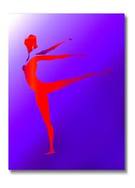
Dancers like athletes put their bodies under constant physical demand. With a demanding training schedule, the many rehearsals, and then the big "event" of the performances, dancers become easily prone to injury. Many dancers ignore pain and believe they need to accept discomfort as part of being a "dancer"; pain is the red flashing light that something is wrong. With fear of any injury, dancers are afraid they will be told not to dance an extended period of time; this may threaten the chances for a great role because they become "unreliable" or "a risk to work with". This is the reality of being a dancer...STRESSFUL! Muscle Release Therapy (MRTh®) and Therapeutic Massage are both effective for releasing muscles, fascia tension, and to restore muscular-skeletal balance. Taking care of your body to prevent injury is extremely important. Ignoring the warning signs can increase the risk of chronic injury and even become career threatening.
"You need to run the choreography one more time", or "take another class", either way this can become taxing on one's body. Your hips begin to feel tired, tense, and soreness starts to set in. Overuse is the most common cause of muscular imbalances with dancers. The repetitive demand can cause tissue damage and block coordination of muscles. When certain muscles are not firing to the greatest capacity other muscles are going to pick up the slack. Dancers are trained to center movement around the left leg. Moving and gesturing more with the right side of the body long term can cause imbalance. I have worked with many dancers who are extremely hyper mobile and counterbalance movement with the piriformis; their gluts lack in proper stabilization while the hamstrings take a great amount of the load.
Dancers need to have balance between flexibility, strength, and fascia tension....ah! don't we just love fascia?! Fascia is a nice panty hose like arrangement of collagen fiber. Fascia surrounds each muscle and the group of muscles, which connect from the head down to our toes. First the muscular skeletal system must be in balance. Tightness around the neck and shoulders can cause the superficial back line to be compromised, leading to "tight" hamstrings limiting freedom of movement. Micro tears can develop from training, stretching, and injury. Fascia will then rebuild itself, as the collagen regenerates - it does so in an unorganized thicker arrangement. The tissue can cause tightness and may also make it difficult for the nerves to slide with ease. This will restrict movement and flexibility while causing pain; breaking up and rebalancing these tissues is crucial. A Massage Therapist can work through the restricted parts of the body. As a mover, it can be extremely difficult to know where the body is holding, compensation can be hidden very well, especially with a dancer.
I am a dancer, teacher, and choreographer; there was a time I would dance 6 to 8 hours a day, along with a couple of dance classes and a rehearsal. I never had any injuries that I can remember; however I do recall I was extremely sore at times. My hips would be sore, and my knees would really hurt as I was walking up those New York City subway steps. I began to take Pilates and Yoga regulary; I was working to keep my body in balance, but I was also demanding a lot from my body each day. I never went to a massage therapist to help me with alignment and recovery. Then my body relived one injury after the other, I even lost my spatial awareness. I tell my students all the time to receive help for their injuries, pain, and discomfort. "You only get one body, so take care of it. You have to take it with you when you grow old". I wish I would have taken better care of myself when I was a young dancer and extremely active. But, with my lessons learned I love working with dancers today, I encourage dancers (as well as any athlete) to take special care of your body. Muscle Release Therapy (MRTh®), Therapeutic Massage, and rebalancing exercise is crucial for a healthy musculoskeletal balance.
Dance is the reason I became a Massage Therapist, I wanted to increase my knowledge of the body and movement. I am excited to explore and help anyone live a pain free active lifestyle. This article is an overview of my experience with dance and what I have learned studying the body through MRTh®. Please feel free to contact me if you have questions about a specific injury, I would greatly enjoy working with you.
Thank you for your time, as I enjoyed sharing my story with you.
Tanya Mucci, LMT
216-364-0152
[email protected]
 RSS Feed
RSS Feed
